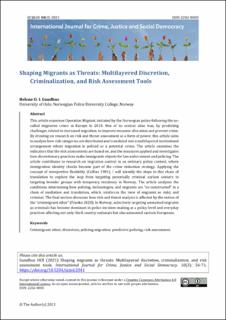| dc.contributor.author | Gundhus, Helene Oppen Ingebrigtsen | |
| dc.date.accessioned | 2022-06-01T10:32:57Z | |
| dc.date.available | 2022-06-01T10:32:57Z | |
| dc.date.issued | 2021 | |
| dc.identifier.issn | 2202-8005 | |
| dc.identifier.uri | https://hdl.handle.net/11250/2997198 | |
| dc.description.abstract | This article examines Operation Migrant, initiated by the Norwegian police following the so-called migration crises in Europe in 2015. One of its central aims was, by predicting challenges related to increased migration, to improve resource allocation and prevent crime. By drawing on research on risk and threat assessment as a form of power, this article aims to analyze how risk categories are distributed and translated into a multilayered institutional arrangement where migration is policed as a potential crime. The article examines the indicators that the risk assessments are based on, and the measures applied and investigates how discretionary practices make immigrants objects for law enforcement and policing. The article contributes to research on migration control in an ordinary police context, where immigration identity checks become part of the crime reduction strategy. Applying the concept of interpretive flexibility (Collins 1981), I will identify the steps in this chain of translation to explore theleap from targeting potentially criminal asylum seekers to targeting broader groups with temporary residency in Norway. The article analyzes the conditions determining how policing, technologies, and migrants are “co-constructed” in a chain of mediation and translation, which reinforces the view of migrants as risky and criminal. The final section discusses how risk and threat analysis is affected by the notion of the “crimmigrant other” (Franko 2020). In Norway, selectively targeting unwanted migrants as criminals has become dominant in police decision-making at a policy level and everyday practices affecting not only third country nationals but also unwanted eastern Europeans. | en_US |
| dc.language.iso | eng | en_US |
| dc.publisher | Queensland University of Technology: Crime and Justice Research | en_US |
| dc.subject | Crimmigrant other; discretion; policing migration; predictive policing; risk assessment | en_US |
| dc.subject | politi | en_US |
| dc.subject | policing | en_US |
| dc.subject | politiarbeid | en_US |
| dc.subject | migrasjon | en_US |
| dc.subject | migration | en_US |
| dc.subject | predictive policing | en_US |
| dc.subject | prediktivt politiarbeid | en_US |
| dc.subject | risk assessment | en_US |
| dc.subject | risikovurdering | en_US |
| dc.subject | trusselvurdering | |
| dc.title | Shaping migrants as threats: Multilayered discretion, criminalization, and risk assessment tools | en_US |
| dc.type | Peer reviewed | en_US |
| dc.type | Journal article | en_US |
| dc.description.version | publishedVersion | en_US |
| dc.source.pagenumber | 56-71 | en_US |
| dc.source.volume | 10 | en_US |
| dc.source.journal | International Journal for Crime, Justice and Social Democracy | en_US |
| dc.source.issue | 3 | en_US |
| dc.identifier.doi | https://doi.org/10.5204/ijcjsd.2041 | |
